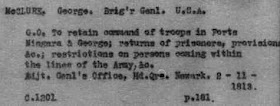Soon after the surrender of 1812, British officers were sent round to disarm the citizens. One of them came to the door of Mrs Dodemead [in Detroit], who had in her care a little, old, dried-up, bedridden woman from Canada, whom she had kindly provided with a home. "Madam," said the officer, as Mrs. Dodemead opened the door, "
I am ordered by Colonel Proctor to disarm the citizens, and take all guns to the fort. Have you any in your house?"
Mrs. Dodemead replied that she had "one British piece." "Follow me," she said, and leading the officer up stairs, she threw open a bedroom door, and
pointing to the old lady said, "There, sir, is a British piece, all that I have. Seize her!" The officer turned on his heel, made a spring, hit the top, the middle, and the lower stair in his flight, and never called on Mrs. Dodemead again.
[Source]


















